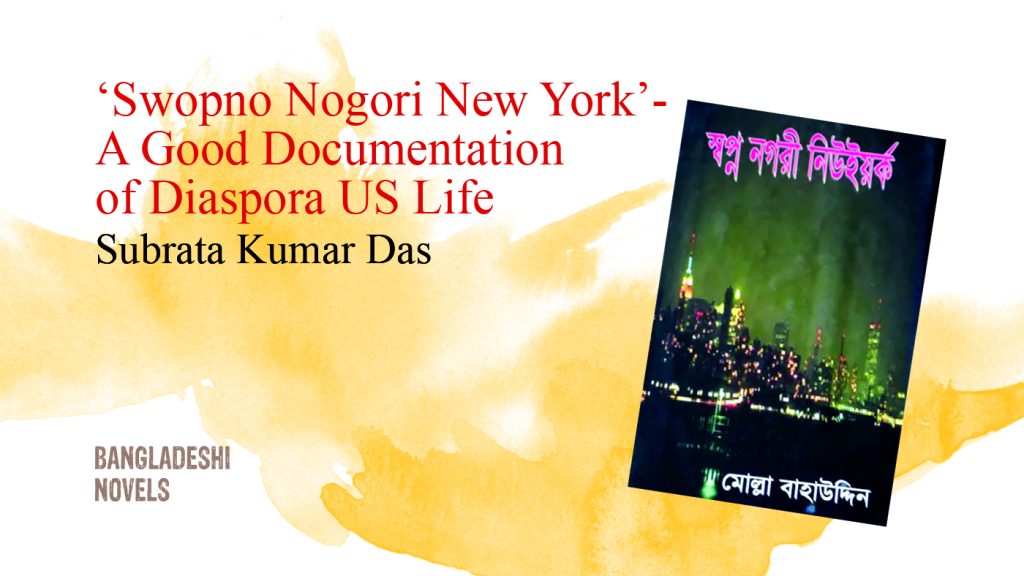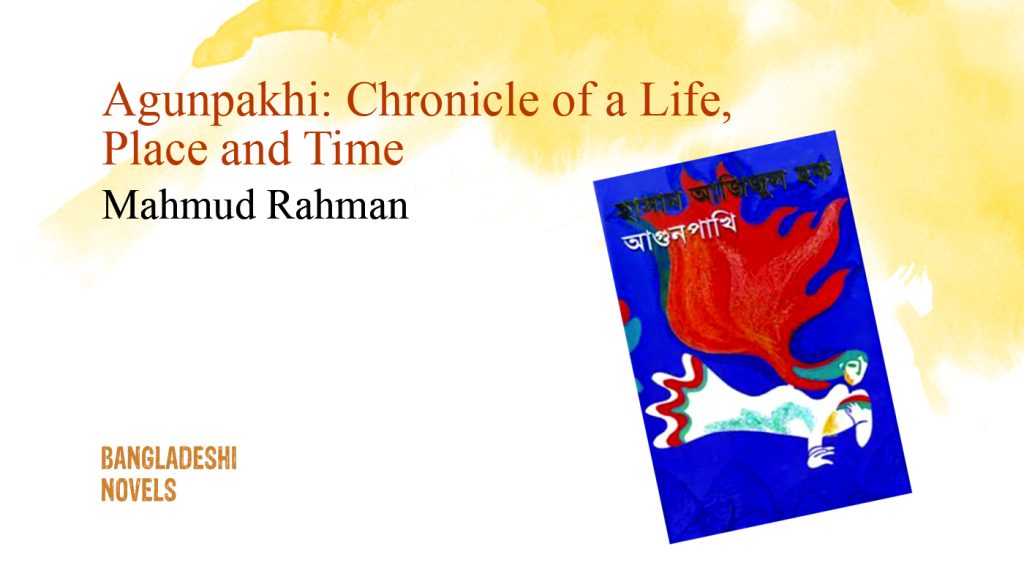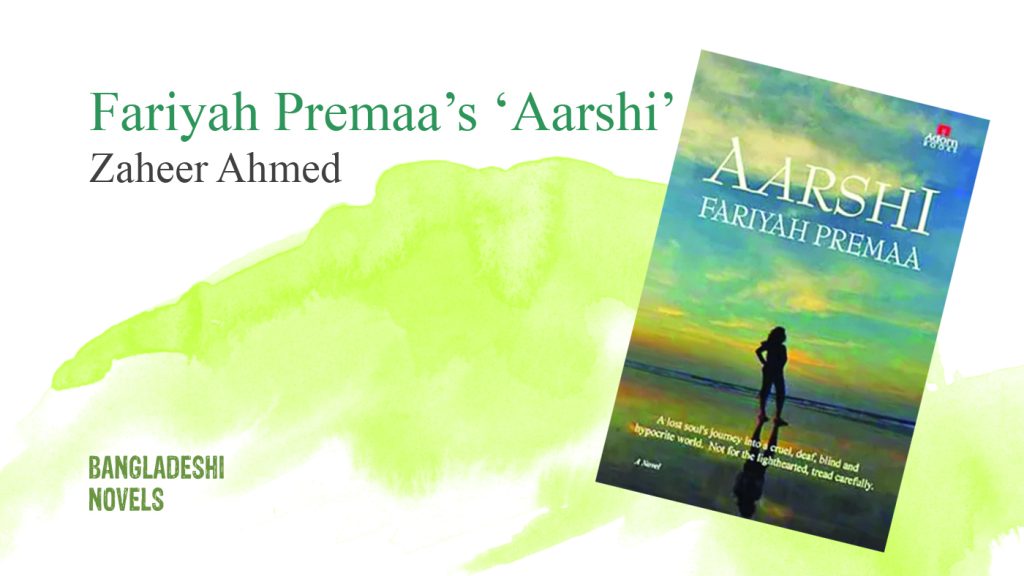
Selina Hossain (b 1947), one of the major novelists of Bangladesh, has been contributing remarkably for the last thirty years. Since the publication of her first novel Jalochchhwas (The High Tide, 1972) she never paused. In the years 1994, 1995 and 1996 she brought out the three parts of her voluminous effort Gaayatree Sondhya (The Pious Evening), a result of ten years as she claims. In this eight hundred odd-page book she has delineated a story or many stories that encompass the total politico-social history of the land of the world map called Bangladesh in a time span from 1947 to 1975.
Along with a good number of volumes of essays and short stories Selina Hossain is mostly prolific in writing novels. After Jalochchhwas with which she started her authorial life, she wrote Hangor Nodi Grenade (A Shirk, River and Grenade, 1976) Magna Chaitanye Shis (A Whistle in an Absorbed Sensibility, 1979), Japita Jiban (A Spent Life, 1981), Neel Moyurer Jouboan (The Youth of a Blue Peacock, 1983), Padashabdwa (The Footfall, 1983), Chandbene (The book is named after a mythological hero, 1984), Pokamakarer Gharbasati (The Households of the Insects, 1986), Nirantar Ghantadhwani (The Continuous Bells, 1987), Ksharan (Exudation, 1988), Kantatare Prajapati (A Butterfly under the Barbed Wire, 1989), Khun O Bhalobasha (Murder and Love, 1990), Kalketu O Fullora (Named under the literary characters of the mediaeval age, 1992), Bhalobasha Pritilata (Pritilata and Her Love, 1992), Taanaporen (The Dilemma, 1994), Deepanitwa (Deepanitwa, 1997), and Juddha (War, 1998). And we must agree that she has been properly acclaimed by her readership. Excluding Bangla Academy Award, she has by now bagged Dr. Muhammad Enamul huq Gold Medal, (1969), Alawol Literary Award (1981), Kamar Mustary Smriti Award (1987), Philips Literary Award (1988), Lekhika Sangha Swarnapadak (Woman Writers’ Society Gold Medal, 1989), Ananya Literary Award (1994) and Alakta Literary Award in 1994.
In her novels Selina Hossain is always very much conscious of the time and society she is writing about. It has been her favorite game to recast time as a living protagonist. And resultantly some of her novels have been recognized as historical novels. Her mastery is that she is never hesitant in portraying time, however past or near it is. For her affinity to historical presentation she draws her stories from the Bangali society of Charjya era i.e. of thousand years back, or of the middle ages or the age happened in our fresh memory. The other characteristic feature of her novels is she does not weave the story-lines in an ordinary sense, rather she exposes the social history of the time of the story with the touch of political milieu or sometimes political accounts get upper hand. In her Chef d’oeuvre Gaayatree Sondhya she moulds her story with particular emphasis on political development of Bangladesh beginning with 1947, when the whole nation was engulfed in darkness. For long twenty four years they struggled to be illuminated and their struggle succeeded through the august liberation war of 1971. But the sorry saga is again that darkness began to hover over the sky of the country and on August 15, 1975 again a black sheet befell on the liberated country with the assassination of the Father of the nation Bangabandhu Sheikh Mujibur Rahman.
In Gaayatree Sondhya Selina Hossain has divided the whole history of Bangladesh or Bangali nation of 1947 to 1975 into three periods. In the first volume years from 1947 to 1958 has been fictionalized. The next volume covers from 1959 to 1969. And the most eventful period of this country i.e. form 1969 to 1975 is the content of the last volume of the novel. The well-knowledgeable reader can easily assume the reasons of the writer for such a demarcation. The first epoch is marked with the embryonic phase of the national identity which is glorified with the 21st February, 1952 when language movement begins. In the second phase the Bangla-speaking people of East Pakistan or Present Bangladesh prepare themselves for an individual identity which originated from the language movement. And the final stage is the fight for freedom, at what cost no one knows, where all patriotic Bangali man, woman or children are the participants in this way or that.
Before going to the different aspects of the novel let us have an idea on the story line of the novel in a brief. Aalee Ahmad, a resident of Murshidabad of West Bengal enters East Pakistan with his family as many Muslim families did because of insecurity of the Muslim people in India. His wife Pushpita and six-year-old son Prodeepta are also with him. They feel India becomes independent making a good number of her populace dependent and as a result those newly dependent people look for an independent land. On their journey to Rajshahi over the river Mahananda Pushpita, in her advanced stage of pregnancy, feels labour pain. Later on in the train Pushpita gives birth a child who is named Proteek Ahmad. In their journey the family has Fazle Gajee and his mother, Headmaster Nasrullah and his eldest son Mofizul and others of their family and a large crowd of known and unknown Muslims who are shifting for East Pakistan.
At Rajshahi Aalee Ahmad gets a lectureship in Rajshahi College and tries to set up himself and his family as an integral part of this new country. But before long his dreams get shattered. The Muslim league people distort his activities and thoughts. At the same time there happens another development at Nachole of Naogaon where Mofizul and his family reside. Mofizul takes admission into Rajshahi College and begins to take part in political activities. With the news of the killing of Mahatma Gandhi Aalee Ahmad plunges into a great intellectual havoc. At Nachole Headmaster Nasurullah faces the same situation. They both understand that the country has been freed from the foreign domination but it lacks the intellectual freedom yet. In such a time Khaja Najimuddin advocates for Urdu as the state language of Pakistan and as a result reactions among the students, and common people spread all over. Aalee Ahmad does not hesitate to give vent his own ideas in favour of the students’ activities and resultantly he gets manhandled by the Muslim League miscreants. For active political participation police imprison Mofizul. At Nachole the Tebhaga movement reaches the climax under the valiant leadership of Ila Mitra. But for some unplanned actions the whole movement gets spoiled and Ila Mitra is arrested. The heinous killing at Khapra ward occurs such a time. Aalee Ahmad receives Translationfer order to Dhaka.
In Dhaka then the question of language is the most talked-about issue. Mofizul also participates in the movement as a student of Dhaka University and sacrifices himself on 21st February 1952. By now Aalee Ahmad concentrates himself to writing as he cherished the desire for long. Gradually he befriends with many people of the intellectual society. In the mean time Iskandar Mirza enforces martial law in the country. Prodeepta receives whipping from an army man for protesting an army man’s unjust action.
The second volume begins with the story of Prodeepta as a university student. Aalee Ahmad gets a job in Dhaka University. Proteek is introduced to Banya, the daughter of Julekha for whom Aalee Ahmad feels an indomitable inclination. People all around celebrate the birth centenary of Rabindranath Tagore. Political development takes place one after another. In the novel we feel the strong presence of Sheikh Mujibur Rahman. Communal riot launches. Cancer is detected on Julekha’s person. Prodeepta befriends with Monjulica. Julekha dies. Then comes the declaration of India-Pakistan war. Sheikh Mujib moves with his six points. In the mean time Prateek also gets to the university door, when Banya is a college student. Prodeepta steps into a job of a journalist. At some time Aalee Ahmad gets a quarter in the university area. With all these comes 1969. Protests by people of different walks reach the peak. They demand in the processions, they die on the streets as Asad dies. Sheikh Mujib is adorned with the title Bangabandhu (the friend of the Bangla). Pradeepta and Monjulica marry each other. Ayub Khan disappears and Yayahiya comes with another announcement of martial law.
The third volumes opens with the time of the mass movement of the country when every individual and the nation and politics intermingle with one another. Whenever one gives an individual step forward, politics shrouds as we see when Prodeepta and Monjulica go to Sonakhali on a personal trip they become entangled with Noxalite activities. There at Sonakhali the host of them, a feudal Jamidar, is Killed by the Noxalite armed people. Another significance of the trip is Prodeepta and Monjulica’a ardent desire to bring a child and as a result Monjulica conceives. Meanwhile occurs the disastrous natural calamity in the coastal areas of Bhola. Hundreds of thousands of people die. Prodeepta visits the area first for his newspaper, then with a relief team. From there when Prodeepta returns, he returns with Sonali, a mere boy who has lost all his near and dear ones in the disaster. And thus comes the first general election in Pakistan. Bangabandhu and his Awami League win. But the winners do not get the authority. While Monjulica’s father receives transfer order to Syedpore, where Prodeepta experiences another problem of the Bangalies with the Biharies. Political situations worsen. Then comes the historic 7th march. On 23rd March Bangabandhu hoists the flag of the independent Bangladesh. And afterwards? On 25 March Monjulica falls in the thorns of labour as the country also undergoes a tumultuous situation. The night of that day becomes the most black night in the history of the nation. Pakistani Military cracks down on the civil citizens. Prodeepta fails to reach home from his newspaper office and takes shelter in the press club As a part of the tank attack, the press club is also damaged. In the next morning while Prodeepta, on his way home with wounded legs, is noticed by the patrolling military van. Bulu Das, a previously acquainted sweeper of Prodeepta helps him in that critical situation and in the course of the event Prodeepta goes across the Buriganga and thus gets involved in the war. In the other side of the story Monjulica gives birth a son and we gradually know that Proteek is also an active participant in the guerrilla actions operated in the city. As a result of all these Aalee Ahmad is taken off by the anti-liberation Razakaars and tortured severely, and when he returns he is nearly dead. In no time India declares solidarity with the newborn Bangladesh. The far-fetched independence seems at the door-steps but right then happens the disgraceful incident of killing the intellectual by the Rajakaars and Aalee Ahmad falls victim of the infamous act. Prodeepta returns but without his left eye and left hand. After so much bloodshed and loss what people achieved is inconceivable – everything around does not run smoothly. New political crisis emerges. Famine hits the whole country in 1974. And in many dissatisfactory situations Sheikh Mujibur Rahman is killed with which Gaayatree Sondhya concludes.
In such a long narration Selina Hossain illuminates all the political events in the time-period of 1947 to 1975. Language movement, Hindu-Muslim riot, India-Pakistan war, mass movement and finally liberation war are the most significant chapters of our history that are depicted not only in their true historical perspective but in coherent connection with familial and social backgrounds as well.
It is true that Gaayatree Sondhya mostly emphasizes on political sequences and as a result in some rate places the narration seems worthy of a political sociology rather than that of a novel. Barring a few of such sections Gaayatree Sondhya is a novel in the true sense, where we can feel the touch of the inner feeling of the individuals. Aalee Ahmad, Pushpita, Prodeepta, Proteek, Monjulica all appear to us as very lively characters.
No doubt in the novel we meet hundreds of characters who do not take necessary delineation in the theoretical sense. But we should not forget that to design the different political events Selina Hossain has to create those characters for the shake of the true depiction of those events not for characterization only. And for that reason at the end of the novel, we fail to term even any of the most significant characters as the protagonist. Either ‘time’ itself or the spirit of nationality is the protagonist of Gaayatree Sondhya.
In relating the large canvass Selina Hossain has also innovated new episodes along with the main stream of the story. The reader may find some of those episodes less successful and boring out we can not deny their contribution in the exposition of the final truth. In chapter eight of first volume the introduction of Bulu Das-Ohi seems unexpected. Even the meeting of Ohi and Aalee Ahmad appears coincidental. Moreover the long episode of Ohi becomes boring also. In the beginning of the 2nd volume the story of Aabed Aalee does not appear with necessary relevance. Aabed Aalee-Minti story is unnecessarily long also. The story of Nasib Hafizuddin does not appear as unrelated but the insertion of the long novel from pages 127-158 and 164-181 that he writes does contribute less than causes boredom. On the contrary the episodes of Prodeepta and Monjulica’s visit to Sonakhali and Prodeepta’s father-in-law’s family’s shifting (both happen in the 3rd volume) to Syedpore contribute immensely to the main theme of the novel.
In Gaayatree Sondhya we come across many historical personalities who were very well known for different reasons. They speak in the novel in such a way that the reader can not but enjoy their living existence. When we know about Somen Chanda or Ila Mitra or Sheikh Mujib or Shahid Saber it renders us dream-like pleasure. The number of such political and historical figures is no less high and many others are there who, it seems, are sketched on real characters unknown to the general readers.
Gaayatree Sondhya is a novel of crises. The crisis to be a refugee is the most dominant one that prevail over the most parts of the novel. When Aalee Ahmad and his family leaves India for Bangladesh they realize that they do not have a motherland of their own. At Rajshahi when the Muslim League hooligans assault Aalee Ahmad the crisis regenerates. We also observe this insecurity problem when the Hindu people leave East Pakistan for India. Again when the Hindu-Muslim riot starts the question of insecurity revives. During the whole liberation-war-period the black claws of this insecurity never leave the family. We should not forget that the question of insecurity possesses a two-fold meaning regarding outward existence which is mostly applicable to the common folk and the other is intellectual security i.e. security regarding liberty of press which is unavoidable to every member of the intelligentsia.
To consolidate the story of this land starting from 1947 to 1975 Selina Hossain has to revise herself time and again. In many of her previous novels her efforts were praiseworthy but Gaayatree Sondhya assimilates the largest canvass in the fullest details with highest human touch.







